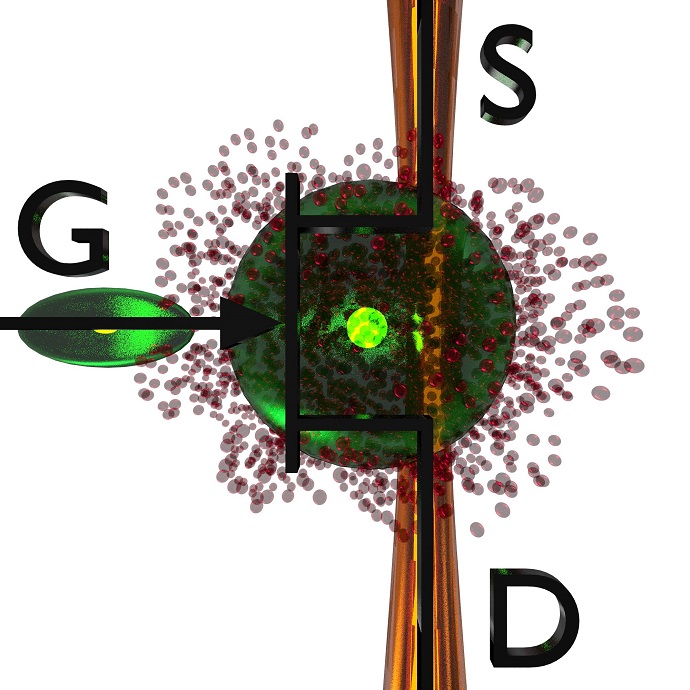July 31, 2014
Devices that employ light for computation, could speed up computers in the future and increase their efficiency. Researchers from the Center for Integrated Quantum Science and Technology (IQST) in Stuttgart have made a key step towards an optical transistor: they can attenuate a weak light beam substantially using one single light particle.
Neither computers nor smartphones would exist without it: the transistor, a tiny electronic switch, is the heart of any computer chip. As opposed to a switch for a lamp, there are no buttons and no actuators on a transistor. An electric voltage controls the current through the transistor.
Computers have gradually gained performance within the past decades because fabrication allows for smaller and smaller transistor sizes such that more transistors fit on a chip, billions nowadays. However, in around ten years, miniaturization will reach fundamental physical limits. Novel technologies will be necessary to further boost the performance and reduce the energy consumption of future computers.
The fast propagation of light compared to the movement of electric charge in a circuit motivates the usage of light as an information carrier for the next generation of computers. But apart from light guides, such an optical computer would need optical transistors in which one light current can control another one, in analogy to the electronic transistor.
For this goal, integrated circuits have to be developed operating on the basis of light instead of electric current.
Unfortunately, this requirement raises problems. Whereas interaction between electrons is very strong, the elementary particles of light, the photons, ignore each other. As a result for a hypothetical optical transistor: one current of light cannot simply switch another one.
This is why physicists are eager to develop techniques that cause interaction between photons. Researchers from the IQST at the 5th Institute of physics at the University of Stuttgart have successfully demonstrated such a technique and used it to build an optical transistor. Remarkably, the smallest amount of light, namely one single photon affects a stream of many photons. More precisely, it attenuates the light beam by 40%.
Physicists from Sebastian Hofferberth’s Emmy-Noether group have sent laser light through a very cold cloud of ten thousand rubidium atoms. For switching, they used a so called Rydberg atom. This is an atom that has gained a factor of 10,000 in size due to the energy of one photon.
It is the enormous size that leads to strong interaction between of Rydberg atoms. A single Rydberg excitation prevents further Rydberg atoms in its vicinity and blocks the whole cloud figuratively.
As long as Rydberg atoms are absent in the cloud, the photons of the laser beam are passed along by the rubidium atoms, similar to a bucket chain. As soon as the Rydberg excitation is present in the cloud, this transport process is suppressed. The researchers found out that one single photon is enough to create a Rydberg atom. The transmission of up to 30 photons can be suppressed that way. So, one photon blocks 30 photons.
This effect can in principle be used for a single photon transistor that switches light with least energy consumption. Based on that, logic circuits can be built for processors and for data communication, on-chip or across long distances.
The findings open up a broad scope. Hannes Gorniaczyk, PhD student at the experiment in Stuttgart: “Our setup enables the detection of single Rydberg atoms.” The measured decrease of the number of photons in the light beam implies the existence of a Rydberg excitation in the first place. A sensor like this can thus proof that a single photon has excited a single electron.
Now, the IQST researchers are upgrading their experiment. One goal would be to extract a stored switch photon without changing its properties. “That way, we could achieve entanglement of multiple photons.” says Christoph Tresp, also PhD student in the project. Entanglement is a strong link between quantum object such as photons. It constitutes a crucial resource for the field of quantum information processing. This extension of information technology uses effects of quantum physics for particularly safe encryption methods or for the so-called quantum computer, which, in some applications, has a high computational speed-up compared to conventional computers.
Original publication:
Hannes Gorniaczyk, Christoph Tresp, Johannes Schmidt, Helmut Fedder, Sebastian Hofferberth: „Single photon transistor mediated by inter-state Rydberg interaction“, Phys. Rev. Lett. 113, 053601 (2014)
Within the framework of the Emmy Noether Programme, the DFG funds Dr. Sebastian Hofferberth and his group within the 5th Physical Institute, since 2011. The research focusses on the development of novel applications of ultracold Rydberg atoms and single photons.
Researchers in the 5th Physical Institute around Prof. Dr. Tilman Pfau investigate the quantum properties of atoms and try to control them systematically to create new states of matter and to find applications in quantum information technology and quantum optics.
The 5th Physical Institute is the founding member of the Center for Integrated Quantum Science and Technology IQST since 2011. The IQST comprises researchers from the universities of Stuttgart and Ulm. The ministry for science and arts in Baden-Württemberg have funded the IQST since 2014 as an inter-disciplinary center for quantum sciences. The goal of the center is to encourage synergies between physics and neighboring engineering and fundamental sciences and to represent quantum science from the basis of research up to technological application.















